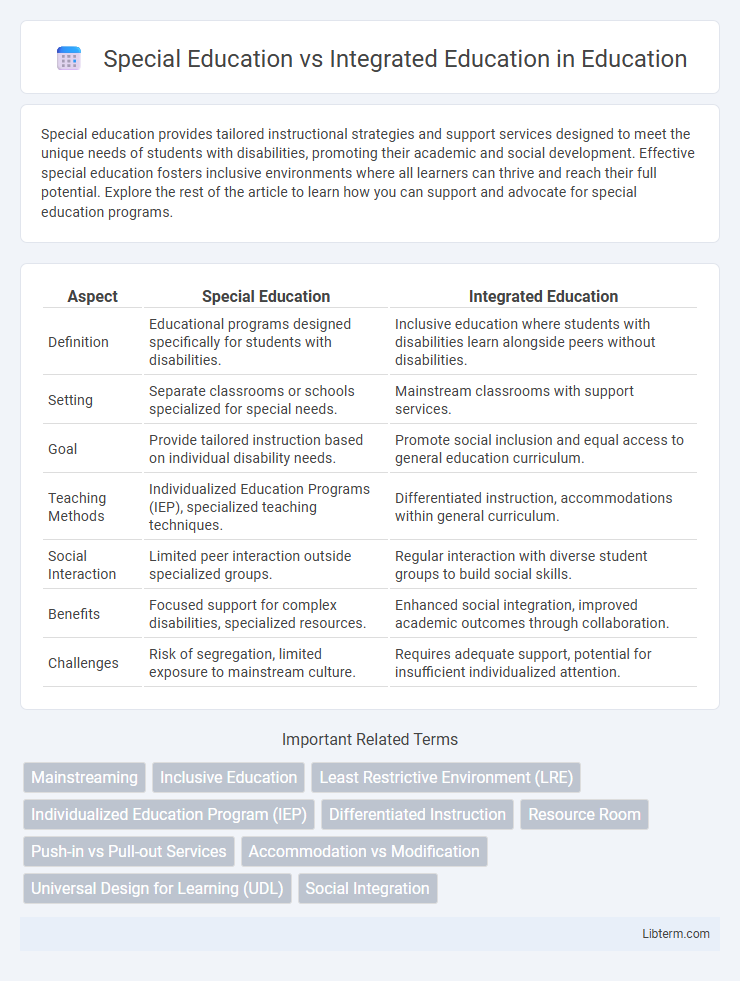Special education provides tailored instructional strategies and support services designed to meet the unique needs of students with disabilities, promoting their academic and social development. Effective special education fosters inclusive environments where all learners can thrive and reach their full potential. Explore the rest of the article to learn how you can support and advocate for special education programs.
Table of Comparison
| Aspect | Special Education | Integrated Education |
|---|---|---|
| Definition | Educational programs designed specifically for students with disabilities. | Inclusive education where students with disabilities learn alongside peers without disabilities. |
| Setting | Separate classrooms or schools specialized for special needs. | Mainstream classrooms with support services. |
| Goal | Provide tailored instruction based on individual disability needs. | Promote social inclusion and equal access to general education curriculum. |
| Teaching Methods | Individualized Education Programs (IEP), specialized teaching techniques. | Differentiated instruction, accommodations within general curriculum. |
| Social Interaction | Limited peer interaction outside specialized groups. | Regular interaction with diverse student groups to build social skills. |
| Benefits | Focused support for complex disabilities, specialized resources. | Enhanced social integration, improved academic outcomes through collaboration. |
| Challenges | Risk of segregation, limited exposure to mainstream culture. | Requires adequate support, potential for insufficient individualized attention. |
Understanding Special Education: Definition and Objectives
Special education is a tailored instructional approach designed to meet the unique needs of students with disabilities, ensuring they receive appropriate support and resources to achieve academic success. It focuses on developing individual educational plans (IEPs) that address specific learning challenges, adaptive skills, and therapeutic interventions. The primary objective is to provide equitable access to education, fostering independence and maximizing each student's potential within a specialized framework.
Integrated Education: Key Concepts and Principles
Integrated education emphasizes inclusive learning environments where students with diverse abilities learn together, promoting social interaction and mutual respect. Key principles include differentiated instruction, collaborative teaching, and providing necessary supports to ensure accessibility for all students. This approach fosters academic and social development by valuing diversity and encouraging participation within mainstream classrooms.
Historical Evolution of Special and Integrated Education
Special education originated in the early 19th century, focusing on segregated schooling for students with disabilities to provide tailored instructional methods and therapies. Integrated education emerged in the mid-20th century, promoting inclusive classrooms where students with and without disabilities learn together to foster socialization and equal opportunities. Legislative milestones such as the Education for All Handicapped Children Act of 1975 and the Individuals with Disabilities Education Act (IDEA) have significantly shaped the transition from separate special education settings to integrated educational environments.
Core Differences: Special vs Integrated Education
Special education provides tailored instruction and support specifically designed for students with disabilities, often in separate classroom settings to address individual learning needs. Integrated education places students with and without disabilities together in mainstream classrooms, promoting inclusion and social interaction while accommodating diverse learning styles. The core difference lies in the educational environment and teaching approach: specialized, individualized interventions versus inclusive, collaborative learning experiences.
Curriculum Adaptations in Special and Integrated Settings
Curriculum adaptations in special education settings often involve individualized education programs (IEPs) tailored to meet specific learning disabilities and developmental needs, using modified materials and specialized teaching strategies. In integrated education, curriculum adaptations focus on inclusive practices that modify instructional content and assessment methods to accommodate diverse learners within general classrooms, fostering collaboration and peer support. These adaptations aim to balance specialized support with access to the general curriculum, enhancing academic and social outcomes for students with disabilities.
Teacher Roles and Professional Requirements
Special Education teachers specialize in individualized instruction tailored to students with disabilities, requiring advanced training in disability-specific strategies, Individualized Education Programs (IEP) development, and behavioral management. Integrated Education demands educators skilled in inclusive teaching practices, differentiating instruction to accommodate diverse learning needs within a general classroom, often necessitating collaboration with special educators and ongoing professional development in universal design for learning (UDL). Both roles emphasize expertise in assessment, adaptive methods, and fostering equitable learning environments, yet Special Education professionals typically hold specialized certifications, while integrated educators balance mainstream pedagogy with inclusive frameworks.
Benefits and Challenges of Special Education
Special education provides customized instruction tailored to students with disabilities, enhancing their academic success and social development through specialized resources and trained educators. Challenges include limited access to services, potential stigmatization, and the high cost of individualized support programs. Effective special education fosters inclusivity and skill development but requires ongoing collaboration among educators, families, and therapists to address diverse learning needs.
Advantages and Limitations of Integrated Education
Integrated education promotes social inclusion and equal opportunities by educating students with and without disabilities together in mainstream classrooms, enhancing peer interactions and reducing stigma. It facilitates access to the same curriculum, improving academic outcomes and fostering empathy, though it may require significant teacher training and resource allocation to address diverse learning needs effectively. Challenges include potential inadequate individual support and the risk of some students being overlooked in larger, heterogeneous groups.
Inclusion Practices in Modern Classrooms
Inclusion practices in modern classrooms prioritize integrating students with special needs into general education settings, promoting equal access to curriculum and social interaction. Special education focuses on tailored instructional strategies and individualized support to meet diverse learning requirements, often through resource rooms or specialized programs. Integrated education bridges these approaches by fostering collaborative teaching and adaptive learning environments that support all students in a unified setting.
Future Trends in Special and Integrated Education
Future trends in special education emphasize personalized learning technologies and inclusive classroom models that support diverse learning needs through adaptive software and AI-driven tools. Integrated education is increasingly adopting universal design for learning (UDL) principles to create flexible curricula and environments that accommodate all students, fostering social inclusion and equal opportunities. Advancements in data analytics and wearable devices are expected to enhance individualized progress tracking and early intervention strategies across both educational approaches.
Special Education Infographic

 libterm.com
libterm.com